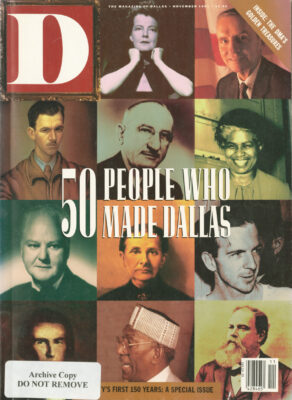The first phone call comes weeks before this issue goes to press. A PR man for a high-profile businesswoman has heard D is naming Dallas’ “50 most influential people.” He also has heard his employer is not among them.
The caller is misinformed on the first point; in recognition of the city’s 150th birthday, our search is for the 50 most significant individuals in the city’s history. Once corrected, the caller goes quietly into the afternoon. Still, the boldness of the query may be matched only by D’s temerity in naming The 50 People Who Made Dallas. Not 50 people currently in power, not the 50 people whose names are chiseled on important buildings, not the 50 people most often found in history books. No, we wanted to name the 50 people who’ve played the strongest roles, for better and, sometimes, worse, in shaping Dallas since its birth,
Our purpose? To recognize those whose single actions or decades of involvement or beliefs have contributed to the internal and external image of Dallas.
Easier said than done.
The process began about three months ago, when D asked Dr. Thomas Smith, director of Old City Park and currently at work on a book about Dallas, to be our primary source. Smith then recruited Dr. Marvin Dulaney, a history professor at the University of Texas at Arlington, and Vivian Castleberry, who is working on a book on the history of women in Dallas. With their help, Smith produced an initial list of more than 100 names, with an emphasis on Dallas’ first 100 years.
From there, in the first of many meetings, D’s senior editors-Chris Tucker, Anne Warren, Ellen Kampinsky and myself- scrutinized the lives of some relatively unknown pioneers while drawing on our knowledge of post-World War II Dallas figures. We knew what we wanted-a listing both substantive and provocative-but we didn’t always know who we wanted. As we added and cut and restored and cut some more, some answers were easy. Other questions remained undecided until the day the magazine was completed.
In the broadest sense, certain choices were based on gut instinct or our desire to reflect the whole Dallas. Our general criteria included: significant impact on Dallas (Babe Didrickson Zaharias and Lee Trevino made greater names for themselves than for the city); contributions of more than money; long-term significance of events and/or ac-tions. We did not establish quotas, yet more than once we counted the number of women and blacks and Hispanics. There was no ’right’number, no automatic membership.
So we began. In a city steeped in religion and business, how strong a role do you give to the arts, to education, to sports? (Roger Staubach, Tom Landry or our choice to exemplify the Cowboys dynasty, Tex Schramm? Everyone knows the city’s sports legends, but how many Dallasites can identify Jerry Bywaters?)
If Dallas was once The City That Works, how strong is the role of those who made it ’”work”? And how do you reflect the changing political and social climate, without showing a bias? (A list without Revs. S.M. Wright and Zan Holmes, but with Al Lipscomb?)
Among philanthropists and humanitarians who could, alone, fill this list (Julius Schepps, Nancy Hamon, Betty Marcus, Nancy Brinker), how do you measure the impact of each generosity?
How do you assess the influence of cultural icons on the city’s image, once you establish the icons? (J.R. Ewing, Stevie Ray Vaughan, Frank Tolbert, John Rosenfield?)
With historical newspaper clippings and other reference materials often sketchy or non-existent, how can we balance the contributions of the long-dead against those of the living? (Sara MinerCallaway vs. Adlene Harrison?)
The decisions quickly became compli-cated, at times mired in a web of futility. And there was a constant tear: Would someone obvious be forgotten? But in the end, the editorial debates, the periodic discoveries of some new detail about an individual and the scouring of several books strengthened our understanding of the city. We hope the final product does the same for D’s readers.
The 50 People Who Made Dallas is a philosophical exercise, but some will want to put a political face on it. We sought to be objective yet definitive, to address the hard questions that often do no( have a right or wrong answer. We know there is more than one such list. Now we await yours.
Related Articles

Arts & Entertainment
VideoFest Lives Again Alongside Denton’s Thin Line Fest
Bart Weiss, VideoFest’s founder, has partnered with Thin Line Fest to host two screenings that keep the independent spirit of VideoFest alive.
By Austin Zook

Local News
Poll: Dallas Is Asking Voters for $1.25 Billion. How Do You Feel About It?
The city is asking voters to approve 10 bond propositions that will address a slate of 800 projects. We want to know what you think.

Basketball
Dallas Landing the Wings Is the Coup Eric Johnson’s Committee Needed
There was only one pro team that could realistically be lured to town. And after two years of (very) middling results, the Ad Hoc Committee on Professional Sports Recruitment and Retention delivered.


